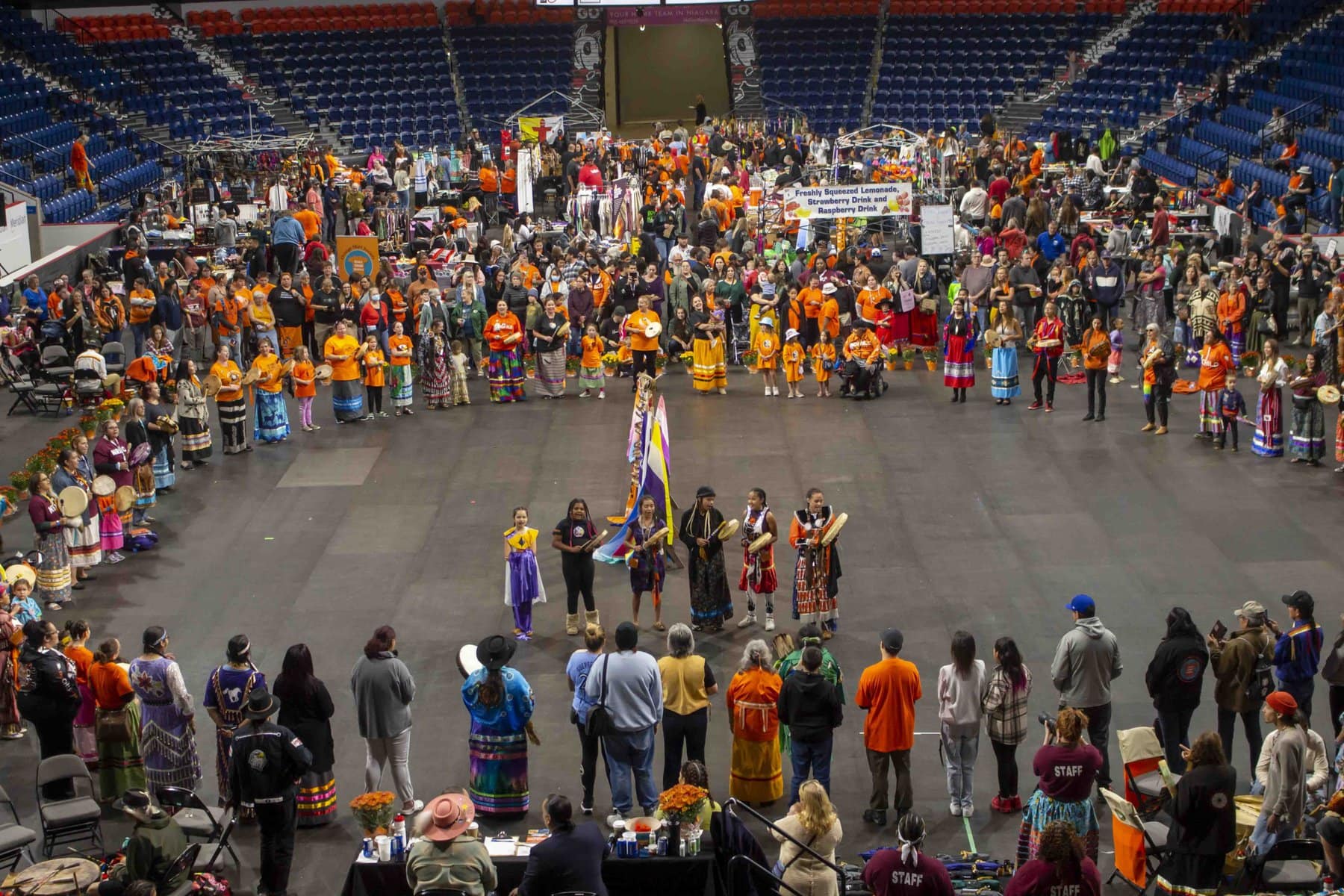The Niagara Regional Native Centre hosted Phyllis Webstad, the founder of Orange Shirt Day, at its eighth annual Nurturing Our Roots powwow last Saturday.
“When I was invited to the powwow I thought it would be a little hall somewhere with 100 people,” Webstad told The Lake Report in an interview.
Instead, she found herself standing before a crowd of nearly 3,000 people in orange shirts at the Meridian Centre in St. Catharines on Saturday afternoon.
“Oh dear, what did I get myself into?” she said with a laugh.
“But it’s been amazing,” she added.
Webstad is Northern Secwpemc from Stswecem’c Xgat’tem First Nation.
She arrived in Niagara two weeks ago to share her truth and reconcile with it.
The trip was funded by the Orange Shirt Society, a non-profit Webstad started at her hometown in Williams Lake, B.C., in 2013.
The organization grew much faster then she anticipated so in 2019, she left a job she loved to run it full-time.
Karl Dockstader, director of the native centre, said they’ve been planning this powwow since before the pandemic.
“Heck of a way to come back,” he said.
Webstad agreed to attend the powwow this spring, after which it “took on a different shape and a different scale,” Dockstader said.
“Nothing that you see today is something that the friendship centre is funded for,” he said.
“This is extra work that they are doing above and beyond.”
Partners of the native centre, like Niagara College, Brock University, the Niagara Catholic District School Board and others were instrumental in making this year’s powwow a reality.
People from across Niagara and beyond attended the powwow.
“To see 3,000 orange shirts up in the stands. I think that that’s more than symbolic,” Dockstader said in an interview.
For Dockstader, it reminds people in the community there are people who want to help.
Indigenous communities did not always celebrate powwows consensually, though.
“We were forced to walk behind them, rather than lead this path, which is our own culture,” Willow Shawanoo-Kechego, the native centre’s community outreach and fundraising co-ordinator, told the Lake Report.
For this reason, MPs and other representatives of government were among the last to enter the powwow floor.
There were many families at the powwow as well. In fact, there was a dance specifically for children, where head dancer Shyann Jenkins ran about dropping candy for the tiny dancers on the floor.
For Shawanoo-Kechego, the feeling the powwow engenders defies description.
“Having my daughter now dance is just something that I can’t even begin to describe,” she said.
The powwow featured performances by drummers, dancers and singers, as well as a place for vendors to sell their wares.
At the start of the powwow, seven different drum circles beat a rhythm for the dancers as they danced onto the floor in ceremonial regalia.
They were led by a procession of flag bearers, eagle staff bearers and honoured guests.
Dancers performed throughout the day, honouring various groups and individuals, including Webstad.
Jingle dress dancers performed a healing dance for the crowd in the afternoon.
Some First Nations communities believe the sound made by the metal cones on jingle dresses heals a person’s spirit.
Powwow attendee Lenora Gilbert was there getting a shirt and book signed from Webstad.
She described meeting Webstad as “honouring” and “humbling.”
“They’re finally being heard,” Gilbert said while looking around at the sea of orange shirts.
Brian Kon, the Indigenous lead for the Niagara Catholic District School Board, has known Webstad for a few years.
They developed a friendship two years ago when Kon lit Niagara Falls orange for Truth and Reconciliation.
The two have been trying to organize a trip to Niagara ever since and this year it finally happened.
“She is so incredibly humble and down to earth. It’s just it’s amazing,” Kon said, while reflecting on how Webstad’s story took off.
That story has become larger than the woman who first told it.
“She will outlive seven generations. Our great-great-great grandchildren will know the name Phyllis Webstad,” Shawanoo-Kechego said.
Webstad was honoured after a crowd of hand drum singers gathered in a circle around the powwow floor to sing and drum the song “Wildflower.”
The circle of drummers sang in unison to honour Webstad, the survivors of residential schools and the children who died and never came home.
Webstad sat down with The Lake Report between book signings to share her story.
“This is our month to have conversations, to go to events, to do what we need to do, to keep the conversation happening,” she said.
Webstad went to St. Joseph’s Mission Residential School when she was six.
She wore a bright orange shirt to school that day, but it was stolen from her, never to be returned.
Today, the orange shirt has become a symbol and Webstad is discouraged to see that symbol change as the movement gets swept up.
Now, she sees the Every Child Matters slogan on black shirts being made as far away as Vietnam.
The Orange Shirt Society was unable to trademark the symbol in 2019 and now the movement has come to “have a life of its own,” Webstad said.
It is “disheartening” to see the shirt designs being stolen by people who don’t know the story behind it, she said.
Webstad said it is important to keep the conversation about residential schools going, even after National Truth and Reconciliation Day every September.
“The world was shocked with the missing children and unmarked burials,” she said, but it was only a portion of the truth – there is still more truth to be told.
“Priests and brothers impregnated the young girls,” she said.
“Children were killed and often thrown in the incinerators alive. That’s another truth that happened all across Canada,” Webstad added, visibly shaken as she wiped at her eyes under her glasses.
There were three girls in the community who were tasked with burning babies at 10 years old, she recalled.
“We have alot of healing to do.”










